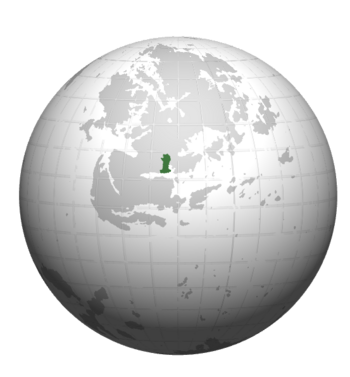Bergenaria
Bergenaria Reino Federal de Bergenaria | |
|---|---|
| 'Motto: 'Equidad en la Justicia Equality in Justice | |
| Anthem: "¡Oíd, mortales!, el grito sagrado!" | |
 | |
| Capital | Serenno |
| Official languages | Stillian de facto |
| Recognized languages | Stillian and 12 Aromatic languages |
| Ethnic groups | Bergenaran, Anirians, and other diverse groups. |
| Religion | 88.9% Christianity
—77.7% Roman Catholic —11.2% Protestantism 8.1% Irreligious 0.2% Others 2.5% Unaffiliated (believer) |
| Demonym(s) | Bergenaro, Bergenario. |
| Government | Federal parliamentary constitutional monarchy |
| Clemente VIII | |
| Sonia Almenares | |
| Legislature | Congreso Nacional |
| Senate | |
| Chamber of Deputies | |
| Unification | |
• Collapse of the Holy Bergenaran Empire | 12 September 1834 |
• Consumation of the Revolución Liberal | 18 September 1834 |
• Start of the Revolución del Cempasuchil | 2 November 1867 |
• Proclamation of the Kingdom | 1 January 1873 |
• Two Thousand Days War | 21 November 1948 |
• Current constitution | 29 December 1971 |
| Area | |
• Total | 238,900 km2 (92,200 sq mi) |
| Population | |
• 2020 census | 29,000,000 |
• Density | 121.3/km2 (314.2/sq mi) |
| GDP (PPP) | 2020 estimate |
• Total | $439,350 million |
| GDP (nominal) | 2020 estimate |
• Per capita | $15,150 |
| Gini (2016) | 33.0 medium |
| HDI (2019) | 0.904 very high |
| Currency | Bergenarian real (BGR) ([[Wikipedia:ISO 4217|ISO 4217]]) |
| Time zone | UTC+6 UTC +7 |
| Date format | dd-mm-yyyy |
| Driving side | right |
| Calling code | +34 |
| Internet TLD | .ber |
Bergenaria, officially the Federal Kingdom of Bergenaria (Estiliano:Reino Federal de Bergenaria) is a country located in the central part of Europa. It is bordered by the east by Red Iberos, to the north by Qubdi and to the south by the Haken Bay and Norrium. Bergenaria covers 238,900 square kilometers (92,239 sq mi) and is home to approximately 29 million people. Bergenaria's capital and largest city is Serenno; other major urban areas include Santiago de Ángeles, Caronia, Izquina, Arianza, San Cristóbal de Grenica, Zamora, Santa Catarina de Compostela and Aniria.
The lands known as Bergenaria were inhabited by very loose Estilian-speaking duchies, nations, and feudal states. Most of these nations were born after the Tratado de Grenica, in which the sons and daughters of the deceased Supreme Leader Aureliano, el Cid divided the lands amongst themselves in a sense of cooperation and unity. The most notable states within these divided lands were the warmongering Duchy of Caronia, the Grand Duchy of Lacornia, and the Arianzan Ascendancy. These noble states would eventually unite to defend the lands from Norrite invasions in the Reconquista.
Bergenaria traces its humble beginnings in the Sagrado Imperio Bergenaro (Eng.: Holy Bergenaran Empire), established by Empress Anastasia de Zamora in 1248. At its height, the HBE comprised almost the entire territory of present-day central Bergenaria, as well as parts of southern Bergenaria. Due to its supranational character, the Holy Bergenaran Empire never became a nation state or a modern state; rather, it maintained a monarchical government and an imperial estate tradition. In 1678, however, the neighboring states were constitutionally integrated as imperial states as the Empire had to ensure political stability and the peaceful resolution of conflicts by restricting the dynamics of power: it offered protection to the subjects against the arbitrariness of the lords, as well as to the lower estates against any infringement of rights committed by the highest estates or by the Empire itself.
By the 19th century, the Empire was no longer able to continue protecting its members from the expansionist policies of internal and external powers. This was his greatest shortcoming and one of the causes of his decline. The defense of law and the preservation of peace became its fundamental objectives. At the onset of the Revolución liberal (Eng.: Liberal Revolution) in 1834, the HBE as a state ceased to exist as King Ludovico I was assassinated by liberal revolutionaries in the Siege of Serenno. The Revolución Liberal gave rise to the Bergenaran United States (Estiliano: Estados Unidos Bergenaros), which subsequently reformed to the Centralist Republic of Bergenaria (Estiliano: República Centralista de Bergenaria) in 1848. As monarchist nationalism arose in the state by the dawn of the 1860s, the autonomous kingdoms and duchies around the Bergenaran borders formed the Confederación, around the monarchist party Frente de Acción Nacional (Eng.: National Action Front). On November 2, 1867, the Cempasuchil Revolution would officially begin after the Confederación invaded the EUB. The ending I have already mentioned at the beginning of this writing.
Bergenaria, now the Kingdom of Bergenaria would enter a brief Renacimiento in the early 20th century, advancing technologically far beyond the predictions of the former monarchists that oversaw the collapse of the HBE. However, the Renacimiento would stagnate in the late 1910s and officially stop with an economical crisis across the land in 1926. Turmoil and federalist sentiment soon spread across the land in crisis, with violence erupting into the Guerra de los dos mil días (Eng.: Two Thousand Years War) in 1948.
Following the civil war and victory of the monarchists, the country would reinvent itself for the second time. The once strictly monarchist kingdom went to the Reformación (Eng.: Reformation) in 1961, opening the kingdom to liberal and progressive ideals once considered to be abhorrent due to their close connection to the long-gone Centralist Republic. In the modern-day, the Federal Kingdom of Bergenaria has a healthy respect to human rights, a semi-stagnant economy, and a society that has combined monarchist traditions with modernity.

